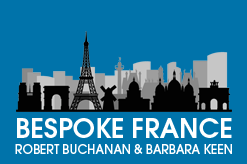Cooking at LA RIBAUDIERE, Charente
Bourg-Charente is an appealing village on the Charente River, between Cognac and Jarnac. It has a good mooring just a few yards from La Ribaudiere, the Michelin-starred restaurant where we have a cooking class next day. Next morning, after a very light breakfast, we’re in the restaurant’s teaching kitchen with Chef Thierry Verrat, who takes us through the three courses we’re going to prepare for our lunch. First, vegetable tarts with langoustines (aka Dublin Bay prawns or scampi), followed by a mushroom risotto with sea bass, and to finish a traditional Tarte Tatin. Phew.
The vegetable tarts have filo pastry bases, which we cut into circles, layer up in a metal ring and cover with tapenade. Meanwhile, the tomatoes are skinned, sliced and de-seeded and put in the oven to dehydrate, and fennel and onion are sliced and cooked in olive oil. We then arrange the vegetables in the tarts, with varying degrees of artistry and a little more oil. While they’re cooking, we get on with shelling and de-veining the langoustines.
The risotto preparation is mainly handled by Chef Thierry, though we lend a hand with some basic veg chopping. But mainly we’re watching and listening for tips on making the perfect risotto. Chef doesn’t bother with keeping the stock on the boil while adding it periodically to the rice - as long as it’s warm, it’s fine he says. He adds that we should keep an eye on the mixture while it’s cooking and stir it at frequent intervals, but not all the time. He uses an aged carnaroli rice from Piedmont for risottos, because of its creamy texture and superior flavour - those features were enhanced by the addition of marscapone and whipped cream at the end of the cooking!
The fish to go with the mushroom risotto will be taken care of later. Now it’s all hands to the knives and peelers, as we prepare a small mountain of apples for our Tarte Tatin, the famous upside-down apple pie. The puff pastry has been made in advance, and we are turning out the peeled, cored and quartered apples that are then caramelised in butter and sugar. When the chef is happy with look of the apples - a process which takes a while and quite a bit of shaking and flipping - no mean feat in a large heavy pan loaded with fruit - he covers them with a pastry duvet. In minutes he has it neatly tucked down around the filling, and painted with egg yolk. He cuts a hole in the centre to release steam and the pan goes in a hot oven for 30 minutes. When it comes out, there’s quite a few minutes over a hot element to remove the remaining moisture and complete the caramelisation, then the scary part - turning the tart over and out.
But the chef simply puts a platter over the pan, does a quick turn, and voila, it’s ready for table - no slips, no drips, no drama. That takes skill, confidence and years of practice.
After a very enjoyable and informative morning, we sat down at the dining table beside the demonstration kitchen to enjoy the dishes. Lunch after a cooking class is quite special - you’re not just the customer, you helped make the meal, which adds another dimension to the experience (even when you realise that the vegetable tart you made is the wonkiest one on the table!)
One of the best cooking classes we’ve had in France - highly recommended, as is the restaurant .
La Ribaudiere, Bourg-Charente - Chef Thierry Verrat is now joined by his son, Julien, after 5 years of cheffing in major restaurants around the world.


